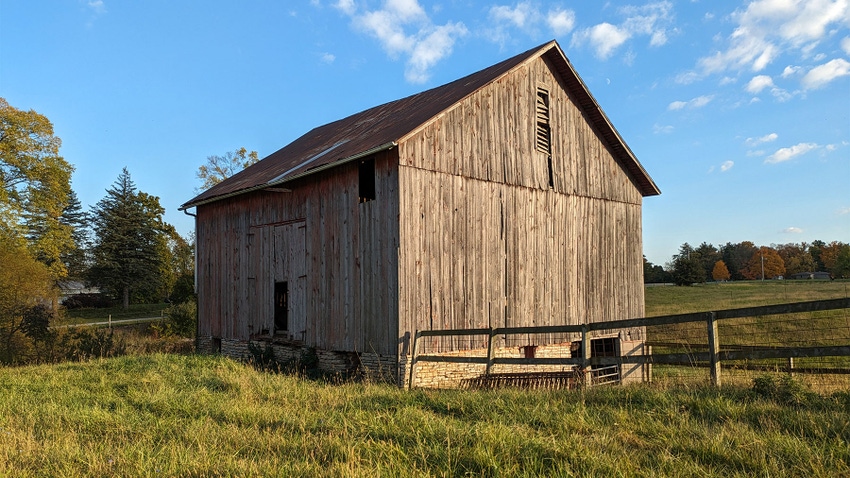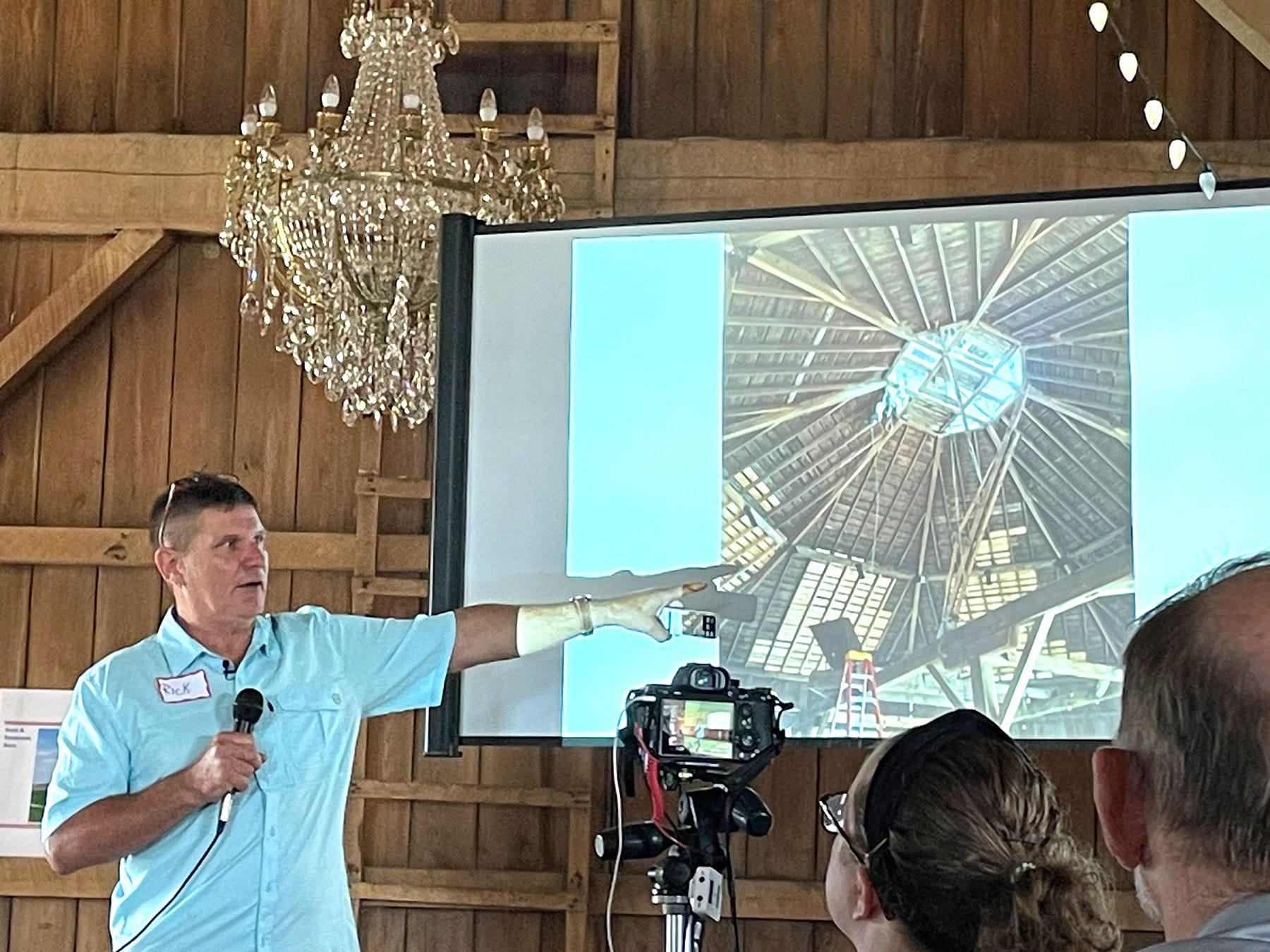November 13, 2023

One hundred years ago, every mile along the countryside featured wooden barns. Take that same drive today and about 90% of those barns have disappeared. Of those that remain, many are in disrepair. Without intervention, neglect and Mother Nature will make them only a memory.
The Indiana Barn Foundation is dedicated to preserving those old barns. Rick Collins, an Illinois-based timber expert and historic building preservationist, led a session on practical restoration tips for the group recently.
Here are 11 points to consider:
1. Your old barn may not be as far gone as you think. “Many of the structures we wind up working on initially appear to be failed or too far gone,” Collins said. “But over my career, I’ve found that I can fix 99% of them.”
2. “We’re not talking decades, we’re talking centuries.” Collins said that with proper restoration and maintenance, old barns are capable of lasting 100, 200, 300 years or more. “I’m currently working on a wood-frame structure in Greece that was originally built in 1390,” he said. “That’s a 600-year wood roof system. Barring bugs and rot, a 600-year roofing system is totally doable. That’s the way these barns can be treated.”
3. What is your vision for your barn? “I like to begin by talking with folks about the history of their old barn, what role it played in their family, and seeing pictures of it from the past,” Collins said. “Then we try to help them look at different options for using the building now and into the future. We do the initial assessment with the end use and budget in mind.”
4. Budget drives the project. For any barn renovation, how much you can spend on the project ultimately determines what gets done. Collins described what he calls “levels of intervention,” or degrees of renovation. Is your goal just to preserve the building by keeping it from falling down? Or do you want a full-on, turnkey renovation?
5. It may not cost as much as you think. “I can design a project that costs $150,000, or I can design a project that costs $50,000, and they’re probably going to accomplish the same thing,” Collins said. “But it’s going to depend on how you want it to look and the end goal. Our company tries to see how much money we can save people.”

START WITH BASICS: Rick Collins shows pictures of a round barn restoration project to the Indiana Barn Foundation at a meeting inside another historic barn. His message? Get practical: What needs to be done? What can you afford to do?
6. A wide assortment of fixes and technologies exist. They include stirrup straps, 3-foot structural screws capable of increasing the strength of a joint connection from 3,000 pounds to 15,000 pounds, and many more. Most can save substantial time and money. “Today we can scan a building, which will give us exact dimensions and save us days of having to measure with a tape measure,” Collins explained.
7. Find a barn renovation expert. Find people who have significant experience. “Those people need to have expertise in repair technologies, timber-frame language and experience working in the field,” Collins said. “Not one or two or three jobs, but 10, 20 or 30. At about 30 jobs, you start to become a subject matter expert. We believe that by using experts, it will not only save you money in the long run, but will result in a structure that will last for centuries.”
8. Decide wood vs. steel. For roofs, Collins feels steel is the way to go, hands-down. “I like wood siding, where possible,” he explained. “It lasts longer, and it’s more aesthetically pleasing. But steel is cheaper, and sometimes that’s a good solution.”
9. Be flexible. Given the life of a properly restored building, its function may change multiple times. The current owner may want it to “look the way it looked when it belonged to Uncle John,” while the next owner may want the doors widened or removed so he can get his tractor in there, Collins said.
10. Take a primer on paint. “Modern paint is like wrapping your building in saran wrap,” he said. “You’re not letting it breathe. I prefer linseed oil-based paints. They don’t peel, pop, ever need to be scraped, and they’re resistant to carpenter bees. They also last longer because they carry pigment into the wood fiber, so you don’t have to repaint every five to seven years.”
11. You are the steward of your barn. “These barns are capable of lasting for centuries, and we’re merely stewards of them now. Someone else will own them when we die,” Collins said. “To what degree do you, as the current steward, feel your responsibility is to that building, and where do you fit in that life cycle? Sometimes just mothballing the building for the next generation, who may have a different vision for it, is a valid goal.”
Learn more: Indiana Barn Foundation
The late Mauri Williamson saw a need to try to preserve what was left of Indiana’s rapidly dwindling number of heritage barns — those built before 1950. Williamson was the longtime executive secretary of Purdue Ag Alumni and founder of Pioneer Village at the Indiana State Fair. In 2013, he became a founding member of the Indiana Barn Foundation.
IBF’s vision is to “raise the awareness of threatened Indiana barns, to increase public and private support of preservation, to encourage the stewardship of historic barns, and to attain significant financial resources to achieve these goals.”
One important service provided by IBF is a free assessment of historic barns. Upon request, an IBF representative will evaluate an owner’s heritage barn and make suggestions regarding feasibility and options for restoring or preserving the structure. The only cost is for mileage. IBF also has a limited number of grants to help with barn restoration.
Individuals or families can join IBF at a very reasonable cost. Member benefits include a quarterly newsletter and invitations to annual barn tours.
“When you think of Egypt, you think of pyramids. When you see a picture of the Midwest, more often than not, it includes a mortise-and-tenon barn or a round barn,” says Kent Yeager, IFB president. “For anyone interested in making sure some of these iconic barns survive, we’re the organization they need to belong to.”
Visit indianabarns.org.
About the Author(s)
You May Also Like






